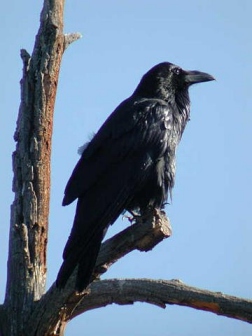|
Large raven
with all-black body, large, stout bill, wedge-shaped tail.
Eats invertebrates, vertebrates, insects,carrion, refuse, eggs and
young of other birds, and rodents.
Strong flight, alternates several deep wing beats with long glides on
flat wings. Soars on thermals, updrafts.

|
COMMON
RAVEN
Corvus corax
PASSERIFORMES
Crows and Jays (Corvidae)
Range
and Habitat
Resident from the Aleutians, northern Alaska and northern Canada south
throughout western U.S. to Minnesota, Great Lakes, and northern New
England; also found in the Appalachians to northwestern Georgia. Preferred
habitats include coniferous forests and rocky coasts; also found in
deserts and arid mountains in the west.
SOUND:
"croooaaak", "cur-ruk", "tok", "wonk-wonk"
Common
Ravens engage in seemingly playful acts such as yanking the tails of
cats and dogs. This may account for the fact that American Indian folklore
often portrays them as tricksters.
In many cultures it is viewed as an auspicious symbol of wisdom, fertility
and creation. However in the
Christian tradition it is considered a bird of ill omen,
heralding evil, warfare and death.
It is an acrobatic flier and has even been observed flying upside down
for as far as one kilometer.
A group of ravens has many collective nouns, including a "bazaar",
"constable", "rant", "storytelling",
and "unkindness" of ravens.
T he Common Raven is a crow which may also be called a
“Northern Raven”. This species is located throughout the
Northern hemisphere, in varied climate regions.
The Common Raven has the largest range in its genus for this fact. Only
those which live in Arctic climates
migrate southward in winter months.

They are omnivores and feed on carrion, insects, food waste from humans,
grains, berries, fruit and small animals. These birds prefer to live
in wooded areas, are opportunistic feeders, and are considered a pest
in regions where they cohabitate with humans. The Common Raven is known
for displaying problem-solving skills as well.
|